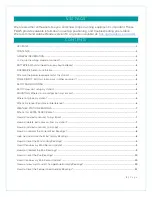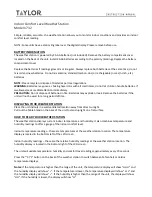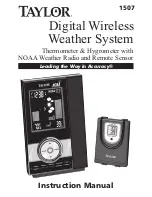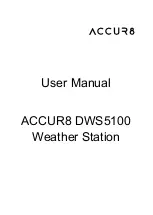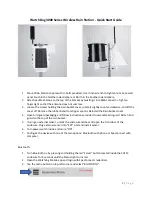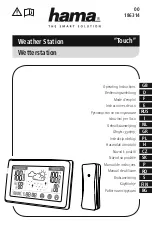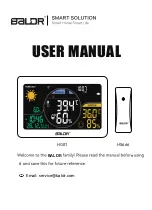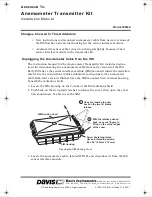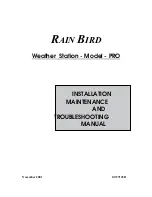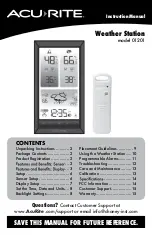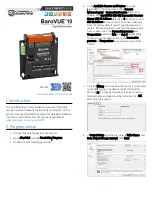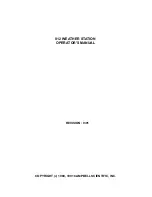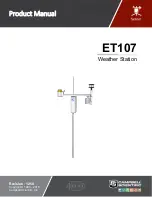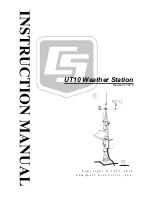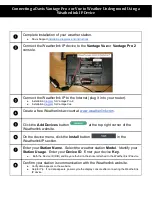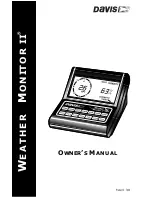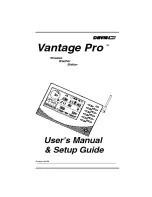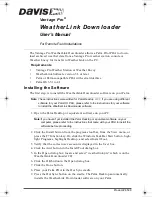
Gamma
instabus
AP 257/31 Wetterstation WS1
AP 257/31 Weather Station WS1
5WG1 257-3AB31
Bedien- und Montageanleitung
Operating and Mounting Instructions
Stand: Februar 2008
As at: February 2008
Bild / Figure 1
Bild / Figure 2
Bild / Figure 3
Bild / Figure 4
Bild / Figure 5
D
Produkt- und Funktionsbeschreibung
Die Wetterstation WS1 (siehe Bild 1) enthält in einem kompak-
ten Gehäuse alle Sensoren, die Auswerte-Elektronik und die
Bus-Ankopplung. Sie misst Windgeschwindigkeit, Helligkeit und
Temperatur, erkennt Dämmerung und Niederschlag und emp-
fängt das DCF77-Funksignal für Datum und Zeit. Neben Datum
und Zeit können alle Messwerte im EIS5-Format auf den Bus ge-
sendet und jeweils auf bis zu 3 Grenzwerte überwacht werden.
Grenzwerte können als Parameter oder als Kommunikationsob-
jekte gewählt werden.
Die Wetterstation ermöglicht nicht nur eine einfache Sonnen-
schutz-Steuerung, bei der abhängig davon, ob die Sonne
scheint oder nicht, der Sonnenschutz aktiviert bzw. deaktiviert
wird. Darüber hinaus kann eine Sonnenschutz-Steuerung für bis
zu 4 Fassaden unter Berücksichtigung ihrer Ausrichtung (Him-
melsrichtung) aktiviert werden. Bei dieser wird der Sonnen-
schutz einer Fassade nur dann automatisch aktiviert, wenn die
Sonne auch auf die jeweilige Fassade scheint und deaktiviert,
sobald dies nicht mehr möglich ist bzw. die Sonne nicht mehr
scheint.
Über das Parameter-Fenster „Sicherheit“ können neben Wind-
alarm, Frostalarm und Niederschlagsalarm insgesamt bis zu 8
Alarm- oder Störungs-Meldungen über eine logische ODER-
Funktion zu einem Kommunikationsobjekt „Sicherheit“ ver-
knüpft werden, das im Alarmfall zum Fahren des Sonnenschut-
zes in seine Sicherheitsstellung führt. Zusätzlich stehen 4 UND-
Gatter und 4 ODER-Gatter mit je 4 Eingängen für weitere logi-
sche Verknüpfungen zur Verfügung.
Zur Parametrierung sollte die Engineering Tool Software ETS3
verwendet werden, da bei ihr die Einstellungs-Menüs der Wet-
terstation grafisch optimal dargestellt werden.
Die Spannungsversorgung der Elektronik erfolgt über AC 20 V
oder DC 24 V Sicherheits-Kleinspannung (SELV). Zur Übertra-
gung dieser Spannung kann das weiß/gelbe Aderpaar der Bus-
leitung genutzt werden.
Weitere Informationen
http://www.siemens.de/gamma
Technische Daten
Sensorik
•
Windsensor: Messbereich: 0 ... 70 m/s,
Auflösung: < 10% des Messbereichs
•
Helligkeitssensor: Messbereich:
0 ... 99.000 Lux,
Auflösung bei:
0 ... 120 Lux
1 Lux
121
...
1.046
Lux
2
Lux
1.047
...
52.363 Lux
63 Lux
52.364 ... 99.000 Lux
423 Lux
•
Temperatursensor: Messbereich: - 40 ... + 80 °C,
Auflösung: 0,1 °C
•
Regensensor:
Heizung: ca. 1,2 W
Spannungsversorgung
•
Busspannung: erfolgt über die Buslinie
•
Busstrom: 9 mA
•
Sensor-Elektronik: AC 20 V +10%, 50/60 Hz oder
DC 24 V + 10%, max. 110 mA, Restwelligkeit < 10%,
max. zulässige Leitungslänge 100 m
•
Leistungsaufnahme: bei AC 20 V: max. 2,2 VA,
bei DC 24 V: max. 2,64 W
Achtung: Beim Einsatz von Schaltnetzteilen kann die Qualität
des DCF77-Empfangs beeinträchtigt werden.
Anschlüsse
•
Spannungsversorgung: Steckklemmen für Massivleiter oder
feindrähtige Leiter 0,5 ... 1,5mm²
•
Busleitung: Busklemme schraubenlos,
0,6... 0,8 mm
∅
eindrähtig, Abisolierlänge 5 mm.
Mechanische Daten
Abmessungen: ca. 118 mm x 96 mm x 77 mm (L x B x H)
Gewicht: ca. 145 g
Elektrische Sicherheit
Schutzart (nach EN 60529): IP44
Umweltbedingungen
•
Umgebungstemperatur im Betrieb: - 30 ... + 50 °C
•
Lagertemperatur: - 20 ... + 70 °C
•
rel. Feuchte (nicht kondensierend): 5 ... 93 %
Prüfzeichen
KNX
EIB
Seite 1 von 2
GB
Product and Applications Description
The weather station WS1 (see figure 1) contains all sensors,
electronic systems for weather data analysis and bus interfacing
in one compact enclosure. It measures wind speed, brightness
and temperature, detects dust / dawn and precipitation and re-
ceives the DCF77 radio signal for date and time. Aside from
date and time, all measured values can be sent to the bus in the
EIS5 format and monitored respectively for up to 3 limit values.
Limit values can be selected as parameters or as communication
objects.
The weather station not only allows for a simple sun protection
control which, depending on whether the sun is shining or not,
activates or deactivates the sun protection. It can also activate a
sun protection control for up to 4 façades under consideration
of their alignment (direction of the compass). In this case, the
sun protection of a façade is only automatically activated when
the sun shines on the respective façade and deactivated as soon
as this is no longer possible or the sun is no longer shining.
In the parameter window “Safety”, not only can wind alarm,
frost alarm and precipitation alarm be set up, but up to 8 alarm
or error messages can be combined using a logical OR function
to create a “Safety” communication object, which can bring the
sun protection into its safety position if it is triggered. In addi-
tion, 4 AND-gates and 4 OR-gates are available with 4 inputs
each for additional logical combinations.
For configuration, the engineering tool software ETS3 should be
used, since it presents a graphically optimal display of the set-
ting menus of the weather station.
The voltage supply of the electronics takes place via AC 20 V or
DC 24 V safety extra-low voltage (SELV). For the transmission
of this voltage, the white / yellow twisted pair of the bus cable
can be used.
Additional Information
http://www.siemens.com/gamma
Technical Specifications
Sensors
•
Wind sensor: Measuring range: 0 ... 70 m/s,
Resolution: < 10% of the measuring range
•
Brightness sensor: Measuring range: 0 ... 99.000 lux,
Resolution at:
0 ... 120 lux
1 lux
121
...
1.046
lux
2
lux
1.047
...
52.363
lux
63
lux
52.364
...
99.000
lux
423
lux
•
Temperature sensor: Measuring range: - 40 ... + 80 °C,
Resolution: 0.1 °C
•
Rain sensor:
Heating: approx. 1.2 W
Voltage supply
•
Bus voltage: via the bus line
•
Bus current: 9 mA
•
Sensor electronics: AC 20 V +10%, 50/60 Hz or
DC 24 V + 10%, max. 110 mA, residual ripple < 10%,
max. permissible cable length 100 m
•
Power consumption: at AC 20 V: max. 2.2 VA,
at DC 24 V: max. 2.64 W
Attention: When using a switching power supply, the quality of
the DCF77 reception may be impaired.
Connections
•
Voltage supply: plug terminals for solid conductors or finely
stranded conductors 0.5 ... 1.5mm²
•
Bus connection: screwless bus terminal,
0.6... 0.8 mm
∅
single-wire, insulation strip length 5 mm.
Mechanical data
Dimensions: approx. 118 mm x 96 mm x 77 mm (L x W x H)
Weight: approx. 145 g
Electric safety
Protection type (according to EN 60529): IP44
Environmental conditions
•
Ambient temperature during operation: - 30 ... + 50 °C
•
Storage temperature: - 20 ... + 70 °C
•
rel. humidity (not condensing): 5 ... 93 %
Markings
KNX
EIB
Page 1 of 2
A5E02038557D DS01



